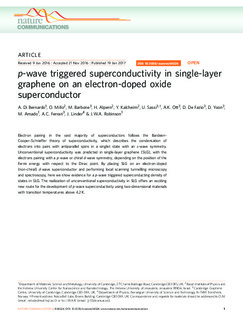| dc.contributor.author | Di Bernardo, Angelo | |
| dc.contributor.author | Millo, Oded | |
| dc.contributor.author | Barbone, Matteo | |
| dc.contributor.author | Alpern, Hen | |
| dc.contributor.author | Kalcheim, Yoam | |
| dc.contributor.author | Sassi, Ugo | |
| dc.contributor.author | Ott, Anna | |
| dc.contributor.author | De Fazio, Domenico | |
| dc.contributor.author | Yoon, Duhee | |
| dc.contributor.author | Amado, Mario | |
| dc.contributor.author | Ferrari, Andrea | |
| dc.contributor.author | Linder, Jacob | |
| dc.contributor.author | Robinson, Jason W.A. | |
| dc.date.accessioned | 2018-01-08T08:11:53Z | |
| dc.date.available | 2018-01-08T08:11:53Z | |
| dc.date.created | 2018-01-07T08:26:19Z | |
| dc.date.issued | 2017 | |
| dc.identifier.issn | 2041-1723 | |
| dc.identifier.uri | http://hdl.handle.net/11250/2476104 | |
| dc.description.abstract | Electron pairing in the vast majority of superconductors follows the Bardeen–Cooper–Schrieffer theory of superconductivity, which describes the condensation of electrons into pairs with antiparallel spins in a singlet state with an s-wave symmetry. Unconventional superconductivity was predicted in single-layer graphene (SLG), with the electrons pairing with a p-wave or chiral d-wave symmetry, depending on the position of the Fermi energy with respect to the Dirac point. By placing SLG on an electron-doped (non-chiral) d-wave superconductor and performing local scanning tunnelling microscopy and spectroscopy, here we show evidence for a p-wave triggered superconducting density of states in SLG. The realization of unconventional superconductivity in SLG offers an exciting new route for the development of p-wave superconductivity using two-dimensional materials with transition temperatures above 4.2 K. | nb_NO |
| dc.language.iso | eng | nb_NO |
| dc.publisher | Nature Publishing Group | nb_NO |
| dc.rights | Navngivelse 4.0 Internasjonal | * |
| dc.rights.uri | http://creativecommons.org/licenses/by/4.0/deed.no | * |
| dc.title | p-wave triggered superconductivity in single layer graphene on an electron-doped oxide superconductor | nb_NO |
| dc.type | Journal article | nb_NO |
| dc.type | Peer reviewed | nb_NO |
| dc.description.version | publishedVersion | nb_NO |
| dc.source.volume | 8 | nb_NO |
| dc.source.journal | Nature Communications | nb_NO |
| dc.identifier.doi | 10.1038/ncomms14024 | |
| dc.identifier.cristin | 1537105 | |
| dc.description.localcode | © The Author(s) 2017. This work is licensed under a Creative Commons Attribution 4.0 International License. The images or other third party material in this article are included in the article’s Creative Commons license, unless indicated otherwise in the credit line; if the material is not included under the Creative Commons license, users will need to obtain permission from the license holder to reproduce the material. To view a copy of this license, visit http://creativecommons.org/licenses/by/4.0/ | nb_NO |
| cristin.unitcode | 194,66,20,0 | |
| cristin.unitname | Institutt for fysikk | |
| cristin.ispublished | true | |
| cristin.fulltext | original | |
| cristin.qualitycode | 2 | |

